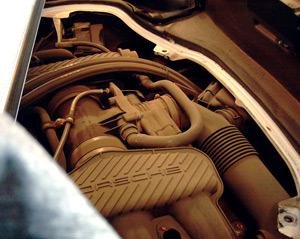 One other special tool needed to work on these cars is patience (See Photo 1). Several components are difficult to see, let alone service. In many cases, several components unrelated to the repair must be removed to complete repairs, so attention to what is involved is important to cover the costs of a repair. Like some other manufacturers, flat-rate times are not always realistic until engine access panels and other considerations are taken into account. There are also a lot of plastic pipes, hoses, covers and caps (See Photo 2) that become very brittle at low mileage; some of which cannot be taken apart without damage.
One other special tool needed to work on these cars is patience (See Photo 1). Several components are difficult to see, let alone service. In many cases, several components unrelated to the repair must be removed to complete repairs, so attention to what is involved is important to cover the costs of a repair. Like some other manufacturers, flat-rate times are not always realistic until engine access panels and other considerations are taken into account. There are also a lot of plastic pipes, hoses, covers and caps (See Photo 2) that become very brittle at low mileage; some of which cannot be taken apart without damage.
Misfires and Fuel Trim
Almost all of the common fault codes we’ve seen with these cars are related to fuel control and misfires. We have customers who use these cars for everything from commuter service to weekend warrior duty at the track, and some use them for both. Many of the male owners we see have already added some kind of performance items before they start to have problems.
As with any diagnosis, a look at the basics must come first. A talk with the customer about use, maintenance and length of ownership is always a good idea for new customers, but with these cars the discussion should be very detailed. Aftermarket performance parts are readily available for these models, but can contribute to both MIL illumination and driveability complaints.
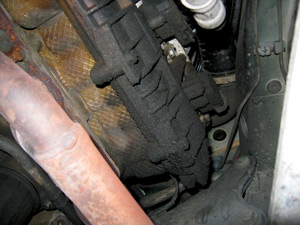 Fuel trim faults can often be traced to vacuum leaks or engine sealing faults due to the remote location of the engine service module in the trunk. Whenever you have fuel trims that set codes such as P1123 or P1125, start by looking for signs of oil seepage. Often the presence of oil on the bottom of the engine (See Photo 3) will lead to a cracked breather or air intake hose. Look carefully around the plastic intake manifold for signs of excessive heat or listen for leaks with the engine running. A smoke generator works great for finding even the smallest of leaks that can cause fuel trim faults that may affect only one bank or both.
Fuel trim faults can often be traced to vacuum leaks or engine sealing faults due to the remote location of the engine service module in the trunk. Whenever you have fuel trims that set codes such as P1123 or P1125, start by looking for signs of oil seepage. Often the presence of oil on the bottom of the engine (See Photo 3) will lead to a cracked breather or air intake hose. Look carefully around the plastic intake manifold for signs of excessive heat or listen for leaks with the engine running. A smoke generator works great for finding even the smallest of leaks that can cause fuel trim faults that may affect only one bank or both.
Because there is no actual PCV valve, any leak in the engine plumbing related to crankcase fumes or intake passages will cause fuel trim faults. Using propane on these cars might be a little difficult due to the layout and placement of the engine. It would however give you a “general” area in which to look for leaks.
MAF problems are no more prevalent on these cars than most others. With higher mileage comes deposits on the sensor that can be removed occasionally with MAF cleaner. Although many shops still use electrical contact cleaner for MAFs, a specific cleaner for this purpose is a better idea. Aftermarket, oiled air filter elements are still pegged for some MAF failures, but usually when the servicing involves not taking the proper steps, not using the proper oil or too much of it.
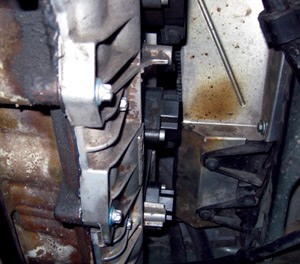 Typical misfire codes like P0300, P0301, etc. can be diagnosed like any other car. Ignition coil failures are common (See Photo 4). Probably the easiest way to determine if the coil is the cause of a single-cylinder miss is to swap the coil from the indicated cylinder to another and see if the code (after clearing) returns to the same cylinder or moves with the coil. So far, wiring harness faults have not been a pattern failure.
Typical misfire codes like P0300, P0301, etc. can be diagnosed like any other car. Ignition coil failures are common (See Photo 4). Probably the easiest way to determine if the coil is the cause of a single-cylinder miss is to swap the coil from the indicated cylinder to another and see if the code (after clearing) returns to the same cylinder or moves with the coil. So far, wiring harness faults have not been a pattern failure.
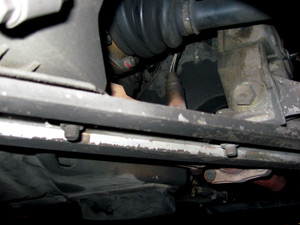 Performance vehicles always seem to attract discussions about which spark plug is best for all-around use. There are just too many factors related to use that makes one spark plug ideal for every purpose. To eliminate the possibility of spark plug-caused misfires, stay with the factory-recommended plugs. Going up or down a heat range may make a difference for commuter or racing use, but the standard plugs are probably best for all-around use.
Performance vehicles always seem to attract discussions about which spark plug is best for all-around use. There are just too many factors related to use that makes one spark plug ideal for every purpose. To eliminate the possibility of spark plug-caused misfires, stay with the factory-recommended plugs. Going up or down a heat range may make a difference for commuter or racing use, but the standard plugs are probably best for all-around use.
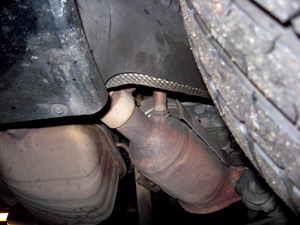 Something to watch for regarding the O2 sensors is their location. The primary (upstream) sensors (See Photo 5) are mounted near the rear axles and the secondary (downstream) sensors (See Photo 6) are located near the rear bumper. On more than one occasion, I have seen or heard of techs replacing the wrong sensors by failing to properly determine banks and the location of the sensors. The connectors are the slide-lock type, but they still seem to get contaminated easily, which can prompt replacement due to incorrect data, when the only problem is corroded electrical connections.
Something to watch for regarding the O2 sensors is their location. The primary (upstream) sensors (See Photo 5) are mounted near the rear axles and the secondary (downstream) sensors (See Photo 6) are located near the rear bumper. On more than one occasion, I have seen or heard of techs replacing the wrong sensors by failing to properly determine banks and the location of the sensors. The connectors are the slide-lock type, but they still seem to get contaminated easily, which can prompt replacement due to incorrect data, when the only problem is corroded electrical connections.
Secondary Air Injection
Almost all of the secondary air injection system faults we have seen have not been the air pump; at least not just the air pump. The air pump should run for up to 50 seconds on a cold start, and may run intermittently to keep the catalysts warmed. We all know that the purpose of the secondary air system is to add additional oxygen to the exhaust to help keep the cats at peak temperature whenever the engine speed is not sufficient to do the same.
If the pump runs but there is no reaction from the O2 sensors, the next step is to check for any leaks in the hoses for the air system. Mentioned above, these plastic hoses tend to get extremely brittle and will often crack if they are disturbed. A smoke test will usually find leaks easily.
If the hoses are all intact, the next most likely culprit will be the air injection valves. On the Boxster, these are located under the intake manifold on each side of the intake plenum. They are difficult to access to test with a vacuum pump. The diagnosis is mostly one of elimination for secondary airflow faults. If the pump runs (and doesn’t scream), the hoses are all intact and a smoke test shows no leaks, then the most likely failure is one, or both, valve(s).










